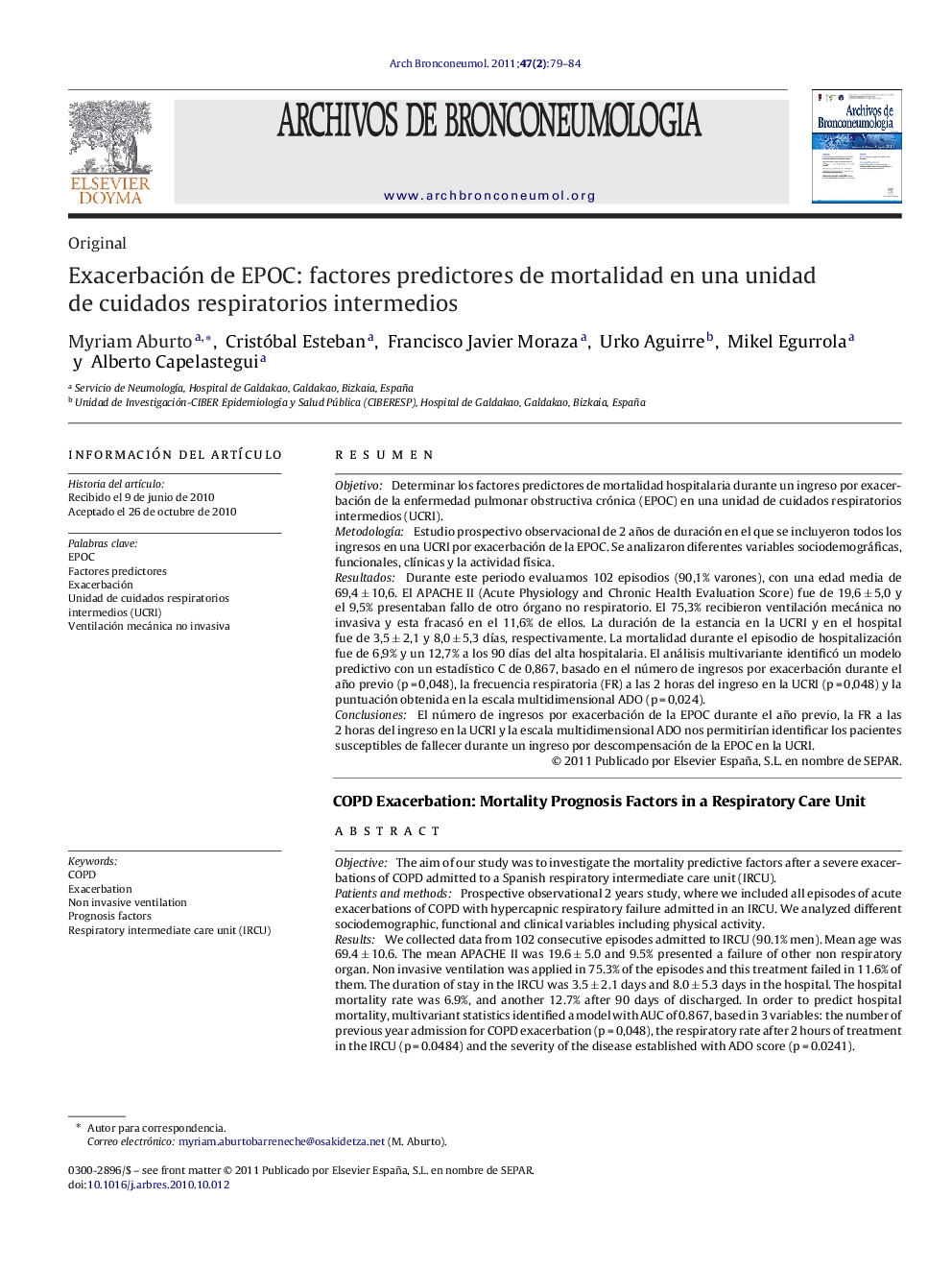| Article ID | Journal | Published Year | Pages | File Type |
|---|---|---|---|---|
| 4203582 | Archivos de Bronconeumología | 2011 | 6 Pages |
ResumenObjetivoDeterminar los factores predictores de mortalidad hospitalaria durante un ingreso por exacerbación de la enfermedad pulmonar obstructiva crónica (EPOC) en una unidad de cuidados respiratorios intermedios (UCRI).MetodologíaEstudio prospectivo observacional de 2 años de duración en el que se incluyeron todos los ingresos en una UCRI por exacerbación de la EPOC. Se analizaron diferentes variables sociodemográficas, funcionales, clínicas y la actividad física.ResultadosDurante este periodo evaluamos 102 episodios (90,1% varones), con una edad media de 69,4 ± 10,6. El APACHE II (Acute Physiology and Chronic Health Evaluation Score) fue de 19,6 ± 5,0 y el 9,5% presentaban fallo de otro órgano no respiratorio. El 75,3% recibieron ventilación mecánica no invasiva y esta fracasó en el 11,6% de ellos. La duración de la estancia en la UCRI y en el hospital fue de 3,5 ± 2,1 y 8,0 ± 5,3 días, respectivamente. La mortalidad durante el episodio de hospitalización fue de 6,9% y un 12,7% a los 90 días del alta hospitalaria. El análisis multivariante identificó un modelo predictivo con un estadístico C de 0,867, basado en el número de ingresos por exacerbación durante el año previo (p = 0,048), la frecuencia respiratoria (FR) a las 2 horas del ingreso en la UCRI (p = 0,048) y la puntuación obtenida en la escala multidimensional ADO (p = 0,024).ConclusionesEl número de ingresos por exacerbación de la EPOC durante el año previo, la FR a las 2 horas del ingreso en la UCRI y la escala multidimensional ADO nos permitirían identificar los pacientes susceptibles de fallecer durante un ingreso por descompensación de la EPOC en la UCRI.
ObjectiveThe aim of our study was to investigate the mortality predictive factors after a severe exacerbations of COPD admitted to a Spanish respiratory intermediate care unit (IRCU).Patients and methodsProspective observational 2 years study, where we included all episodes of acute exacerbations of COPD with hypercapnic respiratory failure admitted in an IRCU. We analyzed different sociodemographic, functional and clinical variables including physical activity.ResultsWe collected data from 102 consecutive episodes admitted to IRCU (90.1% men). Mean age was 69.4 ± 10.6. The mean APACHE II was 19.6 ± 5.0 and 9.5% presented a failure of other non respiratory organ. Non invasive ventilation was applied in 75.3% of the episodes and this treatment failed in 11.6% of them. The duration of stay in the IRCU was 3.5 ± 2.1 days and 8.0 ± 5.3 days in the hospital. The hospital mortality rate was 6.9%, and another 12.7% after 90 days of discharged. In order to predict hospital mortality, multivariant statistics identified a model with AUC of 0.867, based in 3 variables: the number of previous year admission for COPD exacerbation (p = 0,048), the respiratory rate after 2 hours of treatment in the IRCU (p = 0.0484) and the severity of the disease established with ADO score (p = 0.0241).ConclusionsThe number of previous year admission for COPD exacerbation, the severity of the disease established with ADO score, the respiratory rate after 2 hours of treatment, allow us to identified what patients with a COPD exacerbation admitted in a IRCU can die during this episode.
